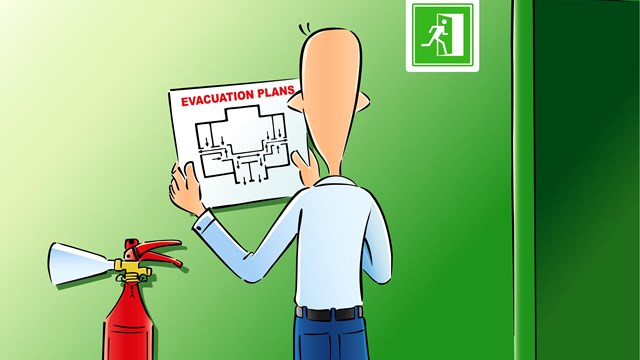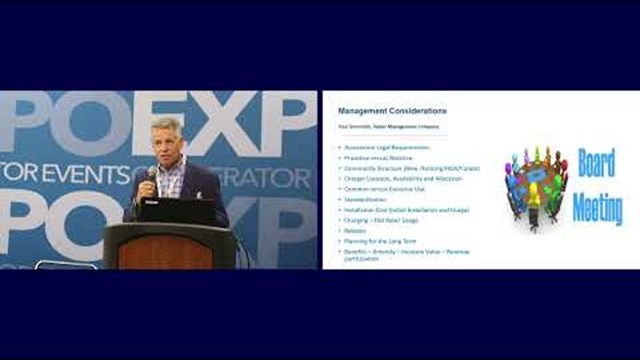
Even cavemen knew that fire was dangerous—and they lived in flame-proof caves. But here in the 21st century, people blithely build roaring fires right in the middle of their furnished, wood-filled, carpeted, upholstered and bookcase-jammed condominiums. And they want someone to tell them it’s safe.
According to Ashley Eldridge, director of education for the Chimney Safety Institute of America (CSIA), the issue of safety and maintenance is particularly important in multifamily buildings, not only because of how those fireplaces and flues are built, but because of the close proximity of families and individuals to their neighbors. A fire can spread quickly in a condo, co-op or townhouse so proper maintenance and safety are vital.
It’s a bit shocking, then, that regular fireplace maintenance is handled in various informal ways by buildings and their managers.There really is no universal standard, though members of the chimney sweeping industry are unanimous in their message: fireplaces are wonderful amenities in any home, but fireplace and chimney maintenance is crucial for the safety and health of building residents and the preservation of their property.
Chimney Concerns
Fireplaces and chimneys may seem like fairly simple mechanisms, but there there are plenty of ailments and problems that can afflict them. And unlike other amenities or equipment that are just rendered less effective by poor maintenance, fireplaces can be made deadly if they are not properly maintained.
According to Thomas Swan, owner of Black Swan Fireside Home, Hearth and Gift in Newtown, Connecticut, poor construction is the foremost problem afflicting the fireplace/chimney structures he sees on a daily basis. “The second most common one is that unfortunately, the average person doesn't have a ton of experience with fires anymore. They'll buy a house and have a fireplace for the first time, and everybody thinks you just pile up wood, light it, and away you go. Same thing with woodburning stoves. There actually is a science to it, and a little bit of finesse to it that people need to learn.”
Michael Stine, manager of Dover, New Jersey-based Elite Chimney Restoration & Maintenance Service, LLC, agrees. When warm flue gas hits cold surfaces—such as the inside of a chimney flue—condensation results. If condensation is accompanied by burning unseasoned “green” wood, dense creosote called “third-degree” builds up. The stuff has the consistency of taffy and is highly flammable. When it clings to the inside of the flue, it can provide the perfect fuel for a chimney fire. “The main danger of fireplaces is always the non-cleaning of them,” says Stine. “People will use their fireplace, and an excessive amount of creosote will build up. And after it builds up to a Stage Three that's when you have a chimney fire.”
Yearly Inspections
There's more than one way to check out a chimney, and more than one level of scrutiny, as Stine alludes to. According to the CSIA, every fireplace and flue should have what's referred to as a Level 1 visual inspection yearly. “It’s inappropriate to assume that if it wasn’t used it doesn’t need to be inspected,” Eldridge says. It’s not just creosote build-up that is dangerous; paper and blown-in litter can pose a threat, along with birds' nests, feathers, and other bits of debris. A lightning strike can also cause damage that cannot be determined without an inspection.
According Stine, a Level 2 checkup involves a camera inspection. “We come in and actually send a camera all the way up looking for any defects or voids in the seams, any breakage, any gaps, anything that's not to code,” Stine says.
Beyond that comes Level 3. “Level 3 is actually ripping down walls for anything hidden,” Stine continues. “So in other words, if your camera picks something up in a Level 2 inspection—let's say a combustible piece of wood—and you're not sure where that is and where it's going, that could necessitate a Level 3—you would have to go in and open the wall and then look.”
Stine says that Level 3 interventions are rare in most modern condos and townhomes. “Nine times out of ten, I never go above a Level 2 with prefabricated fireplaces,” he says. “Usually, the masonry ones that are built pre-1930 are where you get into problems with code, and see more combustibles around the area.” Older homes and buildings tend to have brick-and-mortar fireplaces and chimneys, says Stine, while those in newer buildings are more likely to be prefabricated. Taller buildings can have many fireplaces that are stacked on top of each other with many flues in a single chimney—sometimes as many as 30. With multiple flues, it's not just one unit or apartment that would be affected by a problem in the chimney, it could be them all.
Fireplace professionals stress that annual inspection guidelines apply even to fireplaces that have never even been used, or that get used just a few times a year. “In many cases, the fireplace may get used at Thanksgiving, Christmas, and New Year's and little else,” says Eldridge. “Or you may have a consumer who really enjoys their fireplace and lights it every evening when they get home from work. Those two are going to collect [creosote buildup] very differently. And each fireplace operates differently; based on the height of the chimney, the size of the flue, the type of the fuel.”
Regardless, says Eldridge, “It's important that the venting system be free and clear before you try to light a fire in your fireplace, before the furnace comes on in the cold weather. Even if you didn't use it, it's still important to have it inspected every year to make sure everything's ready to go.”
Chimney Check-up
Most codes state that all chimneys and vents should be inspected and cleaned annually. Speaking generally, inspections can take anywhere from an hour to three hours, depending on the inspection level, complexity, age and accessibility of the structure, and can cost from $65 to upwards of $300 per fireplace. During a professional fireplace/chimney inspection, the inspector will look for any potential fire hazards, as well as assess the condition of the flue, firebox and smoke chamber.
According to the CSIA, the inspector will first take a look at the face of the fireplace to determine if there are any combustible materials such as drapes, rugs, or furniture that could catch fire if an errant spark happens to jump out of the fireplace. Inside the fireplace, the inspector will verify that there is a screen to stop sparks from entering the room, a suitable grate for the firewood, and a properly opening damper. He or she will also check out the brick work and mortar joints, and look for any cracks or loose mortar.
After the firebox, inspectors check out the smoke chamber and the flue, which gives an idea of how dirty the chimney is and whether it has a liner or not. Next, the inspector moves to the roof. There, they look for loose bricks, missing or deteriorated mortar joints, cracked or damaged cement crown, and flashing where the chimney meets the roof. They also check that there is a chimney cap, and look down the chimney to assess the condition of the liner and check for any obstructions.
Many sweeps also insert a camera into the flue to determine creosote buildup as well as debris. Years ago, a buildup of a quarter-inch was considered dangerous, says Eldridge, but recently the tolerance has been changed to just an eighth of an inch. Creosote is acidic, and just that small amount can have an adverse effect on the life of a chimney.
With all these steps, it's vital to have a qualified, properly-trained professional doing your inspection, says Eldridge. “There may be inherent defects with the installation, and until someone who's knowledgeable about chimney construction has the opportunity to assess the actual physical structure, you really don't know; you're taking something of a risk. The whole concept behind our certification process was a means of enabling consumers to determine that somebody is capable and competent and that their advice will, in fact, be good. Other than the obvious technical issues associated with passing an examination, the CSIA certification includes an ethics agreement. So if we find that somebody is taking advantage of people or recommending inappropriate repairs, then they stand to lose that credential."
Sometimes, a simple inspection is all that stands between a unit or building and disaster. Michael Panzarella, owner of Strictly Chimneys in Berlin, Connecticut, remembers a situation that could have been catastrophic, but for a routine call from a homeowner to clean the flue for a wood stove. When he arrived the next day, he discovered that the wood stove, still burning, was dangerously hot to the touch. When he went to the roof, the flue lining, normally orange, was white with heat, and flames were shooting into the air. Panzarella called the fire department. When they arrived, they found that the heat and flame had penetrated the walls, and charred the underside of the hardwood floors. The fire was contained, but “if he hadn’t called me, [the client] could have lost the house,” Panzarella says. As it was, valuable property was destroyed.
While it's not really feasible for a unit owner to clean their own chimney, they can certainly maintain the fireplace itself—and they can make it easier for chimney care professionals to do their job by granting workers access to their unit. "It's not impossible to simply sweep the chimney and not have a look at the front of the fireplace," says Eldridge, "but it's not really adequate." For this reason, most sweeps prefer to have someone representing the condo or association with them as they make their rounds to each unit.
Safety First
Fireplace technology has come a long way since communal pits in caves, but it's still fire, and it's still dangerous, so safety between inspections and cleanings is crucial.
Regardless of the nature or age of your fireplace, hiring a qualified professional to service it for you is crucial to both safety and enjoyment. “The first thing is to see if they're certified by the National Chimney Sweep Guild and if they belong to any guilds in their state,” says Stine. “We belong to the New Jersey Guild for instance. I'm certified by National Chimney Sweep Guild. You can actually go on that website, put in your zip code and they'll tell you what people are certified and what company they're with right there on the computer. That's the biggest thing. You can also check with the Better Business Bureau. If the company is really legitimate, really been around a long time, with live people answering the phones and no telemarketing, then you know you're getting a good company.”
“It's like anything else in the world,” says Swan. “Unfortunately, like a lot of industries, we've been hit by some scam operations that have been a black eye over the last decade. It's just up to the regulating agencies to keep an eye out for that. At the state level, the consumer protection agencies try and do their jobs and protect consumers. But as with any contractor, you want someone with experience; somebody that's done it a while versus somebody in a pickup truck who shows up with a kitchen broom and a five-gallon bucket.”
A crackling, fragrant fire is one of life's little pleasures as the weather gets cold and winter sets in. Fireplaces, whether gas or wood-fueled, are also major value-added amenities in co-op and condo units. With proper installation, care, and professional maintenance, they can function safely for generations to come.
Hannah Fons is the associate editor of The Cooperator. Additional reporting by David Chiu.






Leave a Comment